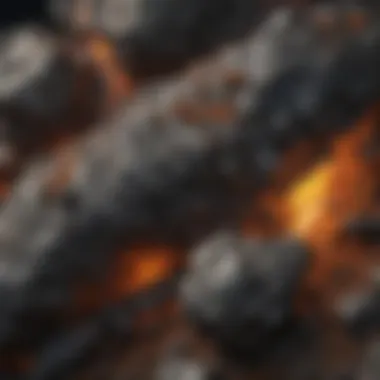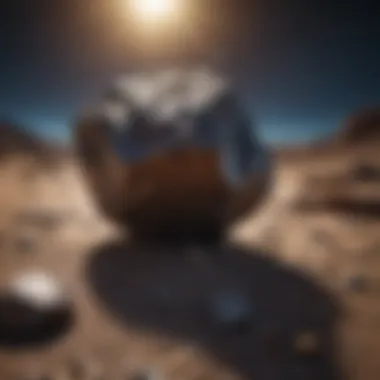Understanding Meteorites: A Guide for Collectors and Enthusiasts


Intro
Meteorites are more than just celestial rocks; they offer a glimpse into the universe's history and the formation of our planet. Understanding their value surpasses mere admiration and beckons an appreciation of geology and the mysteries of space. In this guide, enthusiasts and collectors will learn how to identify, collect, preserve, and display these extraordinary specimens.
Rock and Fossil Identification
Meteorites, although often mistaken for earthly rocks, have unique characteristics that set them apart. To differentiate valuable meteorites from ordinary stones, collectors must develop a keen sense of observation.
Types of Meteorites
There are three primary types of meteorites, grouped mainly by their composition:
- Stony meteorites: Composed mainly of silicate minerals, this type can be further divided into chondrites and achondrites. Chondrites contain small round particles called chondrules.
- Iron meteorites: These consist predominantly of metallic iron and nickel. Their unique fusion crust, often polished, provides clues to their origin.
- Stony-iron meteorites: A mix of metal and silicate, they exhibit a distinct texture. The most famous members of this group include palasites and mesosiderites.
Characteristics to Look For
In terms of identification, certain characteristics should be observed:
- Weight: Meteorites usually possess a far higher density than typical terrestrial rocks.
- Fusion crust: A thin outer layer, created by the heat generated during entry into Earth's atmosphere, often has a distinctive dark, glassy surface.
- Chondrules: Look for those tiny, round structures in chondrites. They often appear like toothpaste droplets within a rock.
- Magnetism: Many meteorites are magnetic. Utilizing a simple magnet can help distinguish a meteorite from regular stones.
Tools for Identification
Collectors benefit from employing a few essential tools in their understanding of meteorites:
- Magnifying glass: Helps examine fine features within meteorites.
- Scale: Compare the weight of a specimen against known rocks for conclusions.
- Magnet: Tests the magnetic nature of the sample, indicating certain metallic contents.
Collecting Tips and Techniques
Once collectors identify meteorites, the collecting journey begins. This phase requires strategies, methods, and knowledge of ethical practices.
Best Practices for Collecting
Engage responsibly when collecting meteorites. Arguable best practices include:
- Get permission: Always seek permission when collecting on private land.
- Respect the environment: Leave no trace of your search. Always maintain an ethical approach to collecting.
- Research locations: Knowledge of meteor showers and known fall spots can direct exposure to successful finds.
Locating Prime Collecting Sites
Meteorites often fall unnoticed in barren areas. Some ideal gathering points include:
- Deserts—specimens have stark contrasts against sandy environments.
- Polar regions—ice preserved meteorites are less disturbed.
- Impact craters—visit locations post-recovery expeditions.
How to Safely Extract Specimens
Proper extraction ensures a specimen remains intact:
- Avoid excessive force.
- Use small hand tools to dig.
- Package the specimen in protective material to avoid damage.
Preservation and Display
Collectors will want their meteorites preserved to safely maintain their wonder. Techniques stem from efficient practices to innovative display solutions.
Techniques for Preserving Meteorites


Preservation methods include:
- Desiccants: Silica gel packs effectively absorb moisture, aiding in a controlled environment.
- Oil coating: Lightly coat iron meteorites to limit rust buildup.
- Sealing box: A transparent, airtight container keeps oxygen exposure minimal.
Proper Storage Methods
It's vital to store meteorites correctly. Some proper methods are:
- Store more valuable specimens away from direct light.
- Keep them at stable temperatures to prevent cracking or pounding surfaces.
- Avoid stacking meteorites that may cause scratches.
Creative Display Ideas
Aesthetic displays can help showcase meteorites:
- Mount meteorites in shadow boxes with informative labels.
- Create themed collections, grouping by type or origin.
- Use mineral trays for a polished, professional presentation.
Geological Insights
The study of meteorites ultimately enriches geological knowledge. These yes, appearances often hold historical and scientific significance that stands beyond various other geological formations.
Geological Formations and Processes
Numerous meteorites narrate the story of early solar system conditions. Collectors uncover parts of asteroids, comets, and even planetary fragments.
Historical Significance of Meteorites
Asteroid involvement shows potential impacts played significant roles in Earth's formation and life evolution.
Notable Discoveries in the Field
Over the years, collectors have made several remarkable discoveries that informed scientific understanding, such as:
- The discovery of the Allende meteorite, which provided insights into solar system formation.
- The Hoba meteorite in Namibia, considered the largest intact meteorite on Earth.
Collecting meteorites certainly has its allure, but it deepens one’s understanding of Earth’s history and the cosmos. Through responsible practices and dedicated efforts, collectors navigate the challenges while fostering a deeper appreciation for these extraterrestrial specimens.
You can start your further exploration on related topics at Wikipedia, Britannica, and communities like Reddit for detailed discussions.
Preface to Meteorites
The study of meteorites intricates a window into the cosmos, unveiling mysteries that have traveled through space. Understanding meteorites is essential for several reasons. First, it grants insight into the history of our solar system, showcasing the building blocks that formed planets. Additionally, for rock and fossil collectors, engaging with meteorites expands their geological knowledge and expertise. They are not just intriguing collectibles; they represent a tangible link to the universe beyond our planet.
As interests in the universe grow, so too does the significance of meteorites. They present opportunities not only for personal enrichment but also contribute to broader scientific discussions around Earth's formation and conditions.
Understanding the categorization and the origins of meteorites facilitates meaningful conversations among collectors and scientists alike. With careers rooted in geology or space science, collectors gain deeper context for their hobby, allowing identification of critical features of various meteorite specimens.
Thus, this section sets a solid groundwork, guiding enthusiasts through essentials of what meteorites are, how they impact our understanding of Earth’s history, and aligning the collectors with a community enriched by knowledge and ethical engagement.
Defining Meteorites
A meteorite is typically understood as any solid fragment from space that survives its passage through Earth's atmosphere and lands on the ground. It differs from meteoroids, which are smaller particles that initiate a bright light phenomenon as they enter Earth's atmosphere—commonly referred to as meteors. Once this fragment successfully lands, it becomes classified as a meteorite, often offering invaluable scientific data about the early solar system.
Meteorites are further categorized based on their composition, morphology, and associated mineral content. These distinctions assist in classifying and identifying the respective origins, thus revealing their provenance.
Why Meteorites Matter


Meteorites possess exceptional importance for multiple reasons:
- Scientific Insight: Each meteorite encapsulates critical data that can provide insight into the conditions and materials present during astrological events in the early history of the solar system.
- Understanding Planetary Formation: Research focused on meteorites can lead to a more profound understanding of planet formation, highlighting both similarities and contrasts amongst celestial bodies.
- Cultural Significance: Aside from their scientific stature, meteorites have found a place woven into the fabric of human history, inspiring myths, art, and folklore across various cultures.
"Meteorites are the cosmic leftovers that showcase how vast and complex our universe is."
In sum, grasping the importance of meteorites underscores the vast opportunities the world holds—where scientific quests coincide with personal discovery within the realm of collection.
The Science Behind Meteorites
Meteorites fascinate scientists and collectors alike. Understanding the science behind them offers insight into their formation, composition, and implications in both geological research and collecting practices. This section focuses on fundamental concepts of meteorites, revealing the benefits for enthusiasts and the critical considerations they face.
Formation of Meteorites
Meteorites originate from various celestial bodies within our solar system. They mainly form from asteroids, which are remnants from the early solar system's formation. When these asteroids collide, fragments break off, and some find their way to Earth. Over millions of years, these fragments have traveled vast distances in space, facing challenges like atmospheric entry and extreme temperatures. The processes, therefore, elicit curiosity not only about their compositional properties but also their age. Sometimes, a meteorite is older than Earth itself. Understanding their formation enriches knowledge for collectors and geologists about the conditions in space that lead to their creation.
Types of Meteorites
Meteorites can be classified primarily into three broad categories based on their composition. Each type possesses specific characteristics and appeals to different interests within the collector community. These types provide valuable information on the compositions and processes of celestial materials.
Stony Meteorites
Stony meteorites are the most abundant meteorite type, comprising around 93% of all known meteorites. They consist mainly of silicate minerals. A primary benefit of collecting stony meteorites lies in their diverse compositions, which can range from ordinary chondrites to enstatite chondrites. Each subtype reveals fragments of our solar system's history. The key characteristic is their resemblance to terrestrial rocks, making them accessible to first-time collectors.
Collectors often find stony meteorites particularly valuable for their representative nature: they serve as connections to celestial events long past.
Metallic Meteorites
Metallic meteorites, often found in the core fragments of larger asteroids, contain primarily iron and nickel. These meteorites, although less common than stony types, hold a distinctive appeal for collectors. The primary aspect to admire among metallic meteorites is their high tensile strength and unique aesthetic. They can develop a characteristic Widmanstätten pattern when etched, making them visually striking. Collectors value this quality deeply. One trade-off, however, is that metallic meteorites are generally heavier compared to their stony counterparts, often complicating transportation and storage.
Stony-Iron Meteorites
Stony-iron meteorites embody components of both stony and metallic meteorites. They're a unique blend, consisting of equal parts silicate minerals and metal. Their hybrid nature provides collectors a more diverse representation of solar system materials. This uniqueness makes stony-iron meteorites a beneficial addition to collections aimed at showcasing variety. However, they can be a lesser-known category among novices. Collecting them requires more knowledge about their origins and the impact from variations in their structures.
Metallic meteorites and stony-iron samples often are sought after for both studiing potential for cosmic minerology and personal enthusiasm. Overall, understanding meteorites' types shows how varied and rich our celestial material's heritage is.
Collecting Meteorites
Collecting meteorites can be an exciting and educational pursuit for enthusiasts and collectors. The passion for meteorites is rooted in their unique position as tangible pieces of space. These objects interest both scientists and hobbyists alike. One main consideration should be understanding the history and classification of meteorites, as this knowledge can greatly impact the value and significance of a collection.
The benefits of collecting meteorites go beyond mere ownership. Engaging with these materials encourages a deeper appreciation of our universe. Collectors often gain insights into geological processes and the formation of planetary bodies. Additionally, possessing meteorites often fosters a sense of connection to cosmic events that occurred eons ago. But, it is essential to navigate this interest with care and ethics in mind.
Getting Started with Meteorite Collection
Beginning your journey into meteorite collecting is vital. Initially, conduct thorough research about the types of meteorites available and their respective value. As a new collector, you may want to:
- Start with meteorites from reputable dealers.
- Familiarize yourself with different classifications and samples.
- Understand the importance of provenance in the collecting process.
Select meteorites that are affordable and appealing, gradually expanding your collection as your confidence grows.
Identifying Authentic Meteorites
Knowing how to identify authentic meteorites is crucial in this field. Engage in regular study of genuine examples. Consider these tips:
- Examine the exterior; authentic meteorites often have a fusion crust that is smooth or glassy.
- Use a magnet to check if the sample is metallic. Many metal-rich meteorites will exhibit magnetic properties.
- Conduct a streak test. Many meteorites have a specific color streak not found on terrestrial rocks.


Learning these methods will help avoid counterfeit or misidentified materials, preserving the integrity of your collection.
Legal and Ethical Considerations
Collecting meteorites carries legal and ethical responsibilities. These responsibilities vary depending on jurisdiction. Key points to keep in mind include:
- Always obtain proper permissions for collection, especially if searching in protected areas.
- Avoid purchasing meteorites that are taken from their natural environment irresponsibly, disrupting the geology.
- Ensure accuracy and honesty when reselling or trading meteorites.
Understanding legal frameworks protects not only your interests as a collector, but also ensures the respect and integrity of the geological community.
Care and Preservation of Meteorites
Once you begin your collection, appropriate care and preservation methods are necessary. Steps to ensure the longevity of your samples involve:
- Storing meteorites in stable environments, avoiding extreme temperature changes.
- Keeping them in airtight containers to minimize exposure to moisture and pollutants.
- Regularly documenting each piece with information regarding when and where it was obtained.
By prioritizing care, you enhance the enjoyment of your collection while safeguarding your investment. Meteorites are not just collectibles; they are remnants of our solar system's history.
Meteorites in Geological Research
Meteorites serve as vital resources for geologists and scientists. Their study provides critical insights into the formation and evolution of our solar systems. By examining the composition and characteristics of various meteorites, geologists can draw conclusions about processes that shaped celestial bodies, including Earth. The examination of meteorites entails benefits, specific considerations, and rich knowledge that ultimately enhances our understanding of planetary systems.
Contributions to Planetary Science
Meteorites hold keys to unlock the mysteries of planetary science. A significant contribution arises from their ability to offer glimpses into the early solar system. Most meteorites are remnants of processes that occurred early in the life of the solar system, often providing well-preserved fragments from different bodies, like asteroids and planets.
- Understanding Composition: Many meteorites have primitive, unaltered features. By studying their mineralogy, scientists can determine the original composition of early planetary bodies.
- Insight into Solar System Formation: Analyzing isotopic dating in meteorites provides relevant information for understanding timelines of events in planetary formation. This helps establish a framework for comparing key events across celestial bodies.
- A Clue to Water’s Origins: Certain meteorites possess water-bearing minerals. By studying these, scientists assess which bodies may have contributed to water on Earth. The implications are vast, as they offer evidence supporting theories around the creation of environments suitable for life.
Additionally, meteorites can reveal impacts on earth and other celestial bodies. They depict collision and aggregation processes influencing planetary evolution, ultimately guiding new models in understanding how planets form and change over time.
The Role of Meteorites in Understanding Earth’s History
Meteorites have an unmistakable role in elucidating Earth's history. Their studies not only highlight diversity among other solar bodies but emphasize Earth's unique development within it.
- Evidence of Early Earth Events: The study of specific meteorite types, such as chondrites and achondrites, can link events that shaped Early Earth to original planetary materials, emphasizing connections between meteorites and terrestrial materials.
- Comparison of Geological Processes: Meteorites that originate from differentiates and undifferentiated bodies showcase various geological processes. This understanding helps elucidate the variances in surface evolution across different bodies.
- Impact on Theories of Life’s Origins: Some scientists hypothesize that certain meteorites may have carried organic compounds crucial to the genesis of life on Earth. Analyzing such meteorites can lead to redefining perspectives on the continuity of life within the universe.
Cultural Significance of Meteorites
Understanding the cultural impact of meteorites enriches the overall appreciation of these fascinating celestial objects. Meteorites have captured human imaginations for centuries, appearing in legends and scientific circles alike. They serve as links between space and earth, forming a unique bridge that has implications for both our ancient narratives and modern uses.
Meteorites in Mythology and Folklore
Throughout various cultures, meteorites have been regarded as messengers from the gods or signs from the heavens. For instance, in many Indigenous cultures, meteorites were believed to possess magical properties, often linked to healing or protection. In China, fragments of meteorites were sometimes thought to bring good fortune, while other cultures viewed them as *bad omens* or heralds of disaster. This myriad of beliefs underscores the universal human curiosity about the origins and nature of celestial phenomena.
Notable Examples
- In ancient Greece, Leonides, a historical figure connected with space, acclaimed a meteorite as divine.
- The famous
Closure
The conclusion serves as an essential summation of the article's insights about meteorites. It highlights the intricate relationship collectors have formed with these celestial specimens. Engaging in meteorite collection is not solely about acquiring physical fragments of space; it grants a unique opportunity to connect with the history of our universe.
Reflecting on the Journey of Collecting Meteorites
Collecting meteorites transforms into a personal journey, marked by exploration and curiosity. As enthusiasts uncover pieces of the universe, it stirs a deep appreciation of Earth’s place in a vast expanse of time and space. This fourteen is also an act of preservation, fostering a responsible approach towards scientific understanding.
Engaging in methodological collecting not only enriches individual collections but enhances scientific research. Successful collectors know that every piece is a narrative of the cosmos. They observe, appreciate, and communicate the stories of these remnants with passion. Ultimately, this journey brings profound satisfaction and a shared responsibility to uphold ethical practices.
Maintaining connections with scientific communities further deepens this passion. Many collectors join forums, attend conferences, or participate in collaborative research, contributing details about new finds or sharing preservation techniques.
To conclude, the venture into meteorite collection is impactful. Believers hope to foster future efforts in understanding outer space while keeping our terrestrial responsibilities in mind.







